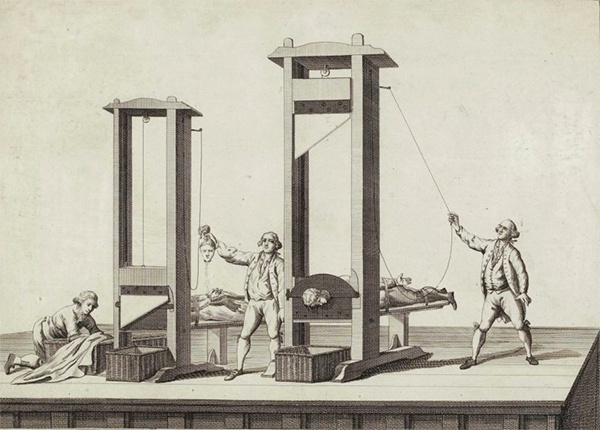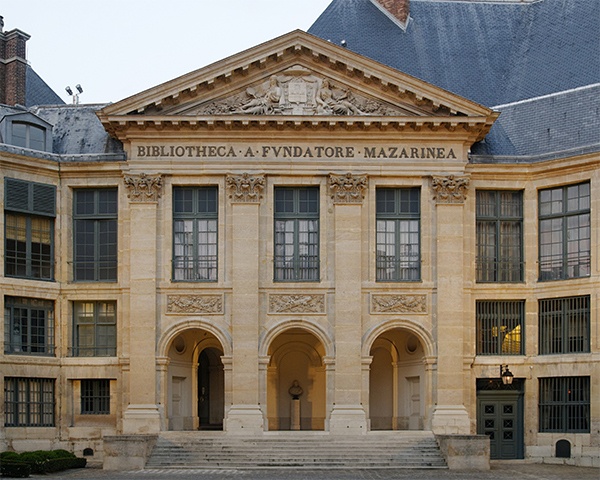Hints and Hindsights. FFFFFF. F to the sixth power.
The six Fs. Fascinating, Fun Facts and Figures about France and French.
They come in handy more often than you’d think: during lulls in parties, as intros or outros to speeches, when you need to prove to some arrogant twit that at least some foreigners know there’s a world beyond Main Street and a timeline that precedes 1776. But let’s not get too arrogant ourselves – even for the most cultivated among us, some of these are real jaw-droppers:

musée de la Révolution française, CC BY-SA 4.0, via Wikimedia Commons
-> When was the last guillotining in France? No, it was not during the 1793 Reign of Terror. It took place in Marseille on September 10, 1977 (that’s nineteen seventy-seven!) to end the life of Tunisian immigrant Hamida Djandoubi, convicted of having tortured and murdered his 21-year-old his former girlfriend, Elisabeth Bousquet. (France abolished the death penalty in 1981.)
-> Speaking of “the national razor,” per one of its approximately two dozen monikers, no, Dr. Guillotin did not invent the machine that bears his name (how interesting that a language that assigns gender to nouns decided to turn “the regretful climb” into a female: la guillotine!). It was designed by another doctor, Antoine Louis, and built by a German harpsichord maker, Tobias Schmidt (get it? Harpsichord? Wood and metal?). Having tested it on sheep then on human corpses, the good Doctor G. intervened by promoting the machine as a “more humane” way of ending a life, saying that all one feels is a “slight breeze on the back of the neck.” (How did he know that?) He was violently against associating his name with “the widow,” but maybe folks back then didn’t like the sound of “being Schmidted.” (Check out the plaque high on the wall at 9, Cour du Commerce Saint-André in the 6è arrondissement, where Schmidt had his workshop.)
->Speaking of sex-sorted nouns, for a country that feminizes such vaunted virtues as la liberté, l’égalité, la justice, la démocratie; whose symbol is Marianne (just look at the image on postage stamps and the statue in your city hall); and where Delacroix’s iconic painting features a bare-breasted Liberty Leading the People, female emancipation did not come a minute too soon. When do you think women got the vote? In 1944! When could they legally open a bank account, manage their own goods and have an occupation without their husbands’ authorization? Starting in 1965!
->A tale of two rivers: The Seine gets its name from the beautiful Sequana, the Gallo-Roman river goddess. “But,” the Seine says to itself, “we are not alone!” There is another river that flows in Paris, but it has been completely buried in tunnels there since early in the 20th century (it runs above ground through parts of the Yvelines, Essonne, Hauts-de-Seine and Val-de-Marne départments). La Bièvre likely took its name, meaning “beaver” (the current French word for the animal is castor), from either its color (ick!) or the tanneries – possibly of beaver skins – that thrived along its bank in medieval times, and it surely gave its name to the neighboring rue de Bièvre, where President Mitterand had a home. (See the post Le Maréchaux for another tidbit about the Bièvre’s flow into Paris. –ed.)
->Speaking of what we generically call “rivers,” French makes a distinction between un fleuve, which flows into a sea or an ocean, and une rivière, which flows into un fleuve or une rivière. La Seine is un fleuve. La Bièvre is une rivière.
->Speaking of the fourth président of France’s fifth république – and his streets – his daughter, Mazarine, was named after the Bibliothèque Mazarine, the library near the Académie Française where he met her future mother. The oldest public library in France, it was born of the personal collection of Cardinal Mazarin (1602-1661), its name, and its nearby namesake street, bearing the feminine finale-“e” thanks to the gender of the type of building it is.

Marie-Lan Nguyen — Travail personnel. Fronton de la Bibliothèque Mazarine, Paris.
->Speaking of Rue Mazarine, it’s in Paris’s book-publishing district (the part of the –6è arrondissement in and around St-Germain-des-Prés). No surprise, then, that some of the stone benches in its Square Gabriel Pierné (composer, conductor and organist: 1863 – 1937) are in the shape of open books. (“Wow! So they are!”)
->Speaking of libraries and personal collections, the Library of Congress as we know it today was started with books that Thomas Jefferson collected at the bouquiniste stalls along the Seine when he was here from 1784 to 1789 as America’s second ambassador. (“I am not replacing Dr. Franklin,” he told King Louis XVI. “No one can replace Dr. Franklin. I am merely his successor.”)
->Speaking of the bouquiniste stalls, they have been there since the mid 1500s, about a century after Guttenberg revolutionized humanity’s relationship with reading. Running on the left bank from Quai de la Tournelle to Quai Voltaire and the right bank from Pont Marie to Quai du Louvre, they have inspired the remark that the Seine is the only river in the world that flows between bookshelves. Their name is thought to come from the Dutch boeckin, meaning “little book.” Like much of everything else in France, the stalls are tightly regulated, with by-laws specifying such details as sidewalk-facing dimensions, Seine-facing dimensions, stall-open dimensions, stall-closed dimensions and operating hours. There’s probably a clause in there somewhere restricting what they can sell, but judging from the day-glo miniature Eiffel Tower keychains, we’re not so sure about that.
By Shari Leslie Segall – a writer who lives in Paris.

